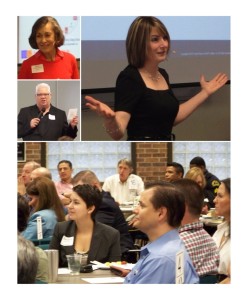X
By Matt Kosec, Adjunct Partner, AMCA
 The enthusiasm was palpable as members of the Servant Leadership Learning Community walked in the room during a rainy April morning. Although we all enjoyed networking with peers who share the journey of servant leadership, everyone in the room was perched on the edge of our chairs as Duane Trammel and Ann McGee-Cooper brought us together to hear the thoughts of Holly Petroff, Associate VP of Client Solutions at the Great Place to Work Institute.
The enthusiasm was palpable as members of the Servant Leadership Learning Community walked in the room during a rainy April morning. Although we all enjoyed networking with peers who share the journey of servant leadership, everyone in the room was perched on the edge of our chairs as Duane Trammel and Ann McGee-Cooper brought us together to hear the thoughts of Holly Petroff, Associate VP of Client Solutions at the Great Place to Work Institute.
Mainstream media, and even Hollywood, often publicize organizations that appear on the “Fortune 100 Best Places to Work” list. These organizations deserve to be celebrated, and perhaps it is a wonderful example of the types of institutions that Robert Greenleaf challenged us to create. Unfortunately, the spotlight is sometimes shined on employee perks as the foundational element of building a great place to work. A culture of valuing employees becomes confused with providing nap pods, ping pong tables, or unlimited candy. In turn, this creates a dangerous trap for leaders. On one side, the leader may be eager to incorporate these types of employee perks, only to be disappointed by zero positive outcomes. Or, the leader may have discovered a new excuse: “We’ll never be able to afford these types of employee perks, so there is nothing we can do to become a better place to work.”
Holly gave us a different and refreshing perspective. Creating a great place to work isn’t created by only employee perks. The true foundation upon which great organizations are built is a concept that servant leaders have long been familiar with – trust. For the Great Place to Work Institute, trust is further divided into credibility, respect, and fairness. Now, those are a little harder to build than an employee coffee bar, aren’t they?
How do we build trust in organizations? Are you ready to form a “trust building” committee and launch a multi-year program? Maybe that is what it will take, but Holly reminded us that we can all start today. According to Holly, the primary trust complaint the Great Place to Work Institute receives is this: “My manager doesn’t look me in the eyes.” Is your workplace the type where others walk head down through the hallways? Are you a top executive who breezes right past employees, not taking a second to make eye contact and ask, “How are you today?” I don’t think this happens on an intentional level; it happens because we are busy managing a large volume of both work and communication. But, as Holly points out, your hard work will be in vain without the trust and commitment of your employees.
In my notebook from this session I have one area highlighted and circled. It was a three step “Trust Check” process that Holly suggested a servant leader who aspires to build higher level of trust use on a daily basis:
- This is what I did to build trust today.
- This is what I did to break trust today.
- This is what I’m going to do to rebuild trust tomorrow.
Of course, I’m ready to pat myself on the back for number one. Two and three, however, ask us all to elevate to humility and vulnerability that are hallmarks of servant leadership. They are excellent reminders that servant leadership is a journey and not a destination.
For the record, our team has installed a make-shift ping pong table and we aren’t afraid to use it. What keeps me committed, though, is that the Chief Operating Officer of an organization of over 4,500 employees has never once walked past me in the hallway without making eye contact and saying, “Hello, Matt.”

